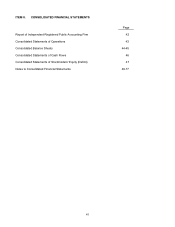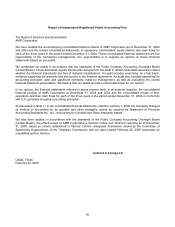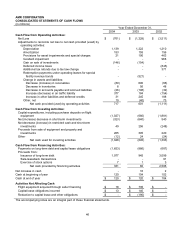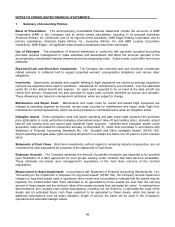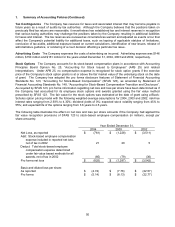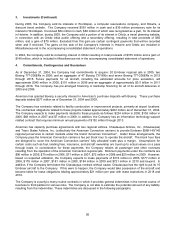American Airlines 2004 Annual Report Download - page 53
Download and view the complete annual report
Please find page 53 of the 2004 American Airlines annual report below. You can navigate through the pages in the report by either clicking on the pages listed below, or by using the keyword search tool below to find specific information within the annual report.
50
1. Summary of Accounting Policies (Continued)
Tax Contingencies The Company has reserves for taxes and associated interest that may become payable in
future years as a result of audits by tax authorities. Although the Company believes that the positions taken on
previously filed tax returns are reasonable, it nevertheless has established tax and interest reserves in recognition
that various taxing authorities may challenge the positions taken by the Company resulting in additional liabilities
for taxes and interest. The tax reserves are reviewed as circumstances warrant and adjusted as events occur that
affect the Company’s potential liability for additional taxes, such as lapsing of applicable statutes of limitations,
conclusion of tax audits, additional exposure based on current calculations, identification of new issues, release of
administrative guidance, or rendering of a court decision affecting a particular tax issue.
Advertising Costs The Company expenses the costs of advertising as incurred. Advertising expense was $146
million, $150 million and $161 million for the years ended December 31, 2004, 2003 and 2002, respectively.
Stock Options The Company accounts for its stock-based compensation plans in accordance with Accounting
Principles Board Opinion No. 25, “Accounting for Stock Issued to Employees” (APB 25) and related
Interpretations. Under APB 25, no compensation expense is recognized for stock option grants if the exercise
price of the Company’s stock option grants is at or above the fair market value of the underlying stock on the date
of grant. The Company has adopted the pro forma disclosure features of Statement of Financial Accounting
Standards No. 123, “Accounting for Stock-Based Compensation” (SFAS 123), as amended by Statement of
Financial Accounting Standards No. 148, “Accounting for Stock-Based Compensation-Transition and Disclosure”.
As required by SFAS 123, pro forma information regarding net loss and loss per share have been determined as if
the Company had accounted for its employee stock options and awards granted using the fair value method
prescribed by SFAS 123. The fair value for the stock options was estimated at the date of grant using a Black-
Scholes option pricing model with the following weighted-average assumptions for 2004, 2003 and 2002: risk-free
interest rates ranging from 2.93% to 4.30%; dividend yields of 0%; expected stock volatility ranging from 45% to
55%; and expected life of the options ranging from 3.6 years to 4.5 years.
The following table illustrates the effect on net loss and loss per share amounts if the Company had applied the
fair value recognition provisions of SFAS 123 to stock-based employee compensation (in millions, except per
share amounts):
Year Ended December 31,
2004 2003 2002
Net Loss, as reported $ (761) $ (1,228) $ (3,511)
Add: Stock-based employee compensation
expense included in reported net loss,
net of tax in 2002 21 20 5
Deduct: Total stock-based employee
compensation expense determined
under fair value based methods for all
awards, net of tax in 2002 (85) (79) (36)
Pro forma net loss $ (825) $ (1,287) $ (3,542)
Basic and diluted loss per share:
As reported $ (4.74) $ (7.76) $ (22.57)
Pro forma $ (5.14) $ (8.13) $ (22.77)



